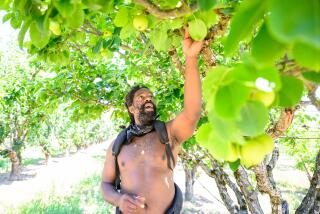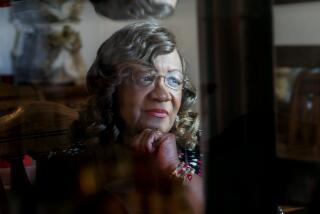Time Erases Site, but Not Memory, of Black Collective : Preservation: Booker T. Washington-inspired Dearfield is fading into the past. Its place in American history is not.
- Share via
GREELEY, Colo. — Except for a green highway marker on a windy stretch of U.S. 34 near Greeley, one sign and some tumble-down buildings are all that remains of one of Colorado’s most idealistic social experiments.
“Dearfield Lunchroom,” the sign reads. “Short order and Quick lunches.”
Commissioned by the lunchroom proprietor and Dearfield’s founder, probably in the 1920s, the sign is accompanied by no landmark plaque, no visitor’s booth, no brochure describing Colorado’s only successful all-black colony.
Founded in 1910 some 25 miles southeast of Greeley, the town grew to a population of about 700 before it was battered by the dust storms of the 1930s.
“It’s a place that should be recognized,” said Paul Stewart, founder and curator of the Black American West Museum and a Dearfield scholar. “I’d like to see it as a historic park.”
In 1984, then-U.S. Rep. Hank Brown (R-Colo.) led an attempt to put Dearfield on the National Historic Register. The Colorado Historical Society commissioned a 64-page historical survey that was completed in 1985.
“They just kind of filed it away. It was forgotten,” said Karen Waddell, a member of the research team that conducted the study under the direction of history lecturer John Albright at Colorado State University.
“We have had so many priorities higher than (Dearfield),” said Barbara Nogren, National Register coordinator at the Historical Society.
Meanwhile, pigeons roost in Dearfield’s decaying lunchroom, old houses have been taken apart for lumber and the streets have lost their definition.
A family with no connection to the colony occupies the old filling station. The earlier residents have long since left the area. Besides a hunting shack, an old hotel and a corral, there is little left but sand, sagebrush, cacti and a few rabbits.
“It breaks my heart that something could come and go like that,” said amateur historian Lois Nord-Malinowski, whose work prompted Brown’s inquiries. “I was taken aback that I could drive through it and never know the history.”
It was the lunchroom proprietor, O.T. Jackson, who founded the town in 1910. He was a disciple of Booker T. Washington and devoted much of his life to the idea of black farming self-sufficieny.
Like Washington, he believed that self-determination for blacks would be the reward of hard work and economic independence.
“If a community of representative families can be located in a farming community,” he told a black-owned land company in 1909, “it would be laying a foundation for the race.”
Around the turn of the century, here as in other parts of the West, a number of all-black colonies sprang up. In Colorado, there were also settlements in Akron, near Cortez and near Craig.
Only Dearfield, under Jackson’s leadership, survived for any length of time.
Because his was one of many similar requests nationwide, Jackson got no support from Washington’s Colorado Negro Business League, whose statewide convention in 1907 promoted all-black colonies. And he received little support from local prosperous blacks because of his support of Democrats, Waddell said.
Jackson persevered, nonetheless, because of his determination and his white friends in politics.
“Some of the blacks in Denver thought he was an Uncle Tom,” Waddell said. “He wasn’t. He just got what he could from anywhere. He was kind of a lone wolf.”
Born in Ohio in 1862 to former slaves, Jackson settled in Colorado in 1887 and took up farming in Boulder. He faced 16 years of difficulties hiring help, white or black, and sought a better system.
With inspiration from Washington’s book “Up From Slavery,” Jackson set out to realize his dream of establishing an independent, all-black farming community.
His initial inquiries were unsuccessful, but by 1909, because of his help in the Democratic campaign of 1908, he was working as a messenger to Colorado Gov. John Shafroth.
With Shafroth’s backing, a desert claim was filed on 320 acres in Weld County.
That first winter 80 years ago, seven families endured the brutal cold in tents, dugouts and caves, with virtually no firewood. But the Dearfield settlers beat all odds to build a thriving agricultural colony for blacks.
By Jackson’s account, the town in 1915 had 44 frame cabins and plenty of cattle, hogs, chickens, ducks and turkeys. The crops were corn, potatoes, alfalfa, oats and watermelons.
Gradually, the settlers stopped hiring out their labor and worked their own land.
In 1921, Dearfield had about 700 people and land and livestock valued at about $950,000, according to Jackson. But it was more than a collection of farmers.
Tools were shared; information was exchanged; goods were bartered; labor was traded--even with the few white settlers in the area.
“It was a thriving community,” former Dearfield resident Eunice Norris recalled in a documentary film titled “The Need, the Reality, The Dream.”
Along with about 100 other farming communities in northeastern Colorado, Dearfield died in the post-World War I agricultural depression, blown away by the howling winds of the Dust Bowl.
Jackson eked out a living in Dearfield until just before his death in 1948. His niece, Jenny, clinging to the dream, remained until she died in 1973.
Before it was abandoned, historians and former residents say, Dearfield stood for a significant solution to economic and racial problems.
By adopting moisture conservation measures, the settlers managed to get fruit trees and livestock to thrive on the dry plains.
As one of 14 agricultural colonies built by blacks fleeing the persecution of Reconstruction America, Dearfield was a study in racial self-determination.
Joe Mangrum, president of the Black American West Museum, said board members are trying to persuade the Colorado Historical Society to preserve the site.
“The self-sufficiency aspect of it is the most important,” said Mangrum, who works with inner-city gangs.
“O.T. Jackson and Booker T. Washington were men of vision and hope,” he said. “That’s the type of people we need, even today, to succeed.”
More to Read
Sign up for Essential California
The most important California stories and recommendations in your inbox every morning.
You may occasionally receive promotional content from the Los Angeles Times.













